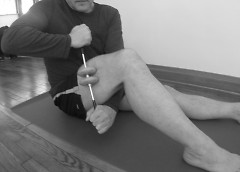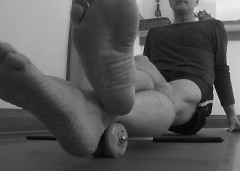It's the high point of spring training for the Gazelle Girl Half Marathon & 5k and that means the potential for overuse injuries. In this informative Q&A, local physical therapist Scott Hadley shares his own personal running story and offers Gazelle Girl runners of all levels great advice on keeping muscles supple and injury free.
Q: As a runner, what have been some of your own personal experiences with injuries and recovery?
A: When I was in college, I developed severe runner's knee (patellofemoral) pain. The pain ended my running career and resulted in a surgery that was probably unnecessary. I tried to start running again when I was in my early thirties, but I was constantly plagued with heel, knee, and hip pain.
When I discovered how impaired stretch reflexes cause pain, I was able to begin the process of correcting the muscle restrictions that were causing all of my problems. My heel pain was due to restrictions in my soleus - or calf. My knee pain was caused by myofascial restrictions in my quadriceps. And my hip pain was a result of gluteus medius stiffness. Once I corrected the muscle restrictions, I was able to start building my mileage without significant problems. I now run 15-20 miles in an average week and keep my body going by self-treatment of the soleus, quadriceps, and gluteus medius.
Q: Many runners are in the middle of their training cycle for spring races. What are the most common overuse injuries you see in your practice?
A: I have a list of common injuries that are due to a break down in stretch reflexes. I call them the Dirty Dozen. Of those, there are six that are caused directly by restrictions in the soleus, quads, and gluteus medius. I call these the Dirty Half Dozen, the most common injuries I see. The Dirty Half Dozen includes plantar fasciitis, heel pain, achilles tendonitis, runner's knee (patellofemoral) pain, IT band syndrome, lateral hip pain. Most cases of plantar fasciitis, heel pain, and achilles tendonitis are caused by restrictions in the soleus. Patellofemoral pain and IT Band Syndrome are most often due to trigger points in the quadriceps. And hip pain is usually due to gluteus medius trigger points. (More on that below)
Q: What are a few core concepts that apply to understanding that patters of muscle stiffness and muscle weakness that cause the majority of overuse injuries?
A: Running involves a lot of shock absorption, so the muscles of the calf, thigh, and hip are prone to fatigue and overuse. Most overuse injuries are part of the bigger problem of poor shock absorption. When the foot lands, the ankle, knee, and hip bend under the forces of gravity and forward momentum. The joint movements cause muscles of the calf, thigh, and hip to stretch rapidly. That rapid stretch activates stretch reflexes between dozens of muscle groups, which all work together to absorb the impact and move us forward.
Fatigue of the shock absorbing muscles causes them to stiffen. When they stiffen, the stretch reflexes become impaired, causing impairments in strength and coordination of the shock absorbing muscles. Some muscles can lose up to 75% of their strength when stretch reflexes are shut down. This leads to muscle pain, faulty joint mechanics, and inflammation of soft tissues.
Many running overuse injuries do not involve inflammation of joints and tendons. A majority of overuse injuries is due to trigger points that develop in the shock absorbing muscles. The trigger points generate pain that is usually felt at the nearest joint or along the muscle tendon. For example, most cases of Achilles tendonitis are simply due to pain from trigger points in the soleus muscle of the calf. So pain isn’t normally from one specific area, but rather from tension on other muscles. Most of the time, the problem is due to stiffness of three muscles: the soleus of the calf, the quadriceps of the thigh, and the gluteus medius of the hip.
Q: What are a few maintenance tips you offer runners to help avoid common overuse injuries?
A: Muscle Rolling is the best way to prevent and treat the most common running injuries. Learning to deeply roll the soleus, the quadriceps, and the gluteus medius is the key to limiting our risk of injury and treating existing pain. Most of the muscle restrictions that lead to pain are very deep within the myofascial tissue. The rolling has to go deeply enough to treat the problem areas of the muscle and to release the fascia that restricts the muscle.
Restoring normal stretch reflexes dramatically improves muscle recruitment and coordination for a runner. Muscles test stronger and are able to do their work with less fatigue when the stretch reflexes work properly. This means better shock absorption, restored joint mechanics, and pain-free running. Learning to correct and prevent stiffness that develops in the soleus, quadriceps, and gluteus medius gives us control over painful conditions like plantar fasciitis, achilles tendonitis, knee pain, IT Band pain, etc.
Q: Why do you prefer deep pressure rolling of the fascia and muscles?
A: Roughly 25% of muscle tissue is made of fascia that surrounds the muscle cells. With overuse, the fascia stiffens, limiting blood flow and inhibiting stretch reflexes. Deeply rolling the myofascial tissue is the only way to correct the restrictions that cause pain. It would be great if simple muscle stretches did the trick. But in most cases, the soleus, quadriceps, and gluteus medius need to be release with deep pressure and manipulation of the fascia.
Q: What tools do you recommend? What works? What doesn't?
A: I have been using a standard kitchen rolling pin and a 10” softball in my clinic for years. It’s funny to me that I still use those two tools for muscle release, because there are so many products on the market made for muscle rolling. But a rolling pin is cheap, and I’m not happy with the design of most specialty muscle rollers.
Foam rolling is probably the most over-hyped idea in the world of muscle rolling. Foam rollers are too soft and are too large in diameter to effectively get into the deeper layers of muscle and fascia. Specialty muscle rollers can work if they are stiff enough and if they have a design that penetrates deeply into the muscle. But many muscle rollers have flexible handles, which prevents you from being able to push deeply enough into the muscle. Rollers like The Stick and TigerTail are pretty good concepts, but they do not have the right surface to dig deeply. They are good at squishing the muscle, but so is my wooden rolling pin. I’m working on my own design for a muscle roller, hopefully to be released in April of this year.
But honestly, knowing HOW to use a muscle roller is the key to success. There is an educational void in the world of self treatment. Most runners use rollers in a random, haphazard way. But there is a science behind rolling. One of my goals is to educate runners about their bodies and how to use that knowledge to run safely and sustainably.
Here's how to "Roll with It:"
For detailed pics, click HERE
1. Roll the Soleus
The soleus forms the bulk of the calf, extending from the Achilles tendon to the knee. Trigger points in the soleus generate pain in the Achilles tendon, heel, and the bottom of the foot. With a relaxed foot, roll the midline of the calf from the Achilles tendon to a few inches below the knee while supporting body weight with hands and the other foot. To increase pressure, cross the opposite leg over the one you are rolling. Rolling deeply improves blood flow, restores flexibility to stiff muscles, reduces trigger point pain, and restores stretch reflexes that control strength and coordination.
2. Roll the Vastus medialis
The vastus medialis is a tear drop shaped muscle in the lower half of the inner thigh, attaching to the inner edge of the patella. Trigger points in the vastus medialis generate pain in the front of the knee. While sitting on the floor or in a chair with the knee bent, roll the inner part of the quadriceps on the front of the thigh.
3. Roll the Vastus Lateralis
The vastus lateralis is the largest muscle of the quadriceps, forming the entire outer side of the thigh. Trigger points in the vastus lateralis create pain that is often mistaken for IT Band Syndrome. Rolling the vastus lateralis works best if the roller is leveraged against the thigh as shown. The lower handle is anchored in place as the upper handle is used to push into the vastus lateralis and roll along the entire length of the thigh. The thigh is essentially squeezed between the roller and the forearm. Long, broad strokes of the roller work best to treat the entire muscle. When tight, painful bands of muscle are found, spend more focussed time on those spots.
4. Roll the Gluteus Medius
The gluteus medius lies on the outer and back side of the hip. Trigger points in this muscle generate pain in the SI joint region, the side of the hip, and into the back of the thigh. To roll the gluteus medius, sit with both knees bent in front of you in a ‘crab walk’ position. Place a hard ball 3-4 inches in diameter under the hip, close to the waist line. The belt falls under the level of the iliac crest. Keeping your foot planted on the ground, let the knee fall outward. This places the ball in a groove created between the top of the thigh and the pelvis. For a really sore gluteus medius, keep both hands on the floor behind you as you move your body left and right (not up and down) along the groove created between the thigh and pelvis. As the muscle relaxes, you can lean down onto one elbow. This straightens the trunk and exposes the gluteus medius, allowing you to roll it more effectively.
Bio: Scott Hadley has a PhD in Anatomy and a Doctorate in Physical Therapy (DPT). Dr. Hadley has published numerous scientific papers in the fields of neuroscience and rehabilitation, served on the faculties of Grand Valley State University, Hope College, and Calvin College, and is the owner of the Hadley Clinic in Grand Rapids, Michigan.
The Rapidian, a program of the 501(c)3 nonprofit Community Media Center, relies on the community’s support to help cover the cost of training reporters and publishing content.
We need your help.
If each of our readers and content creators who values this community platform help support its creation and maintenance, The Rapidian can continue to educate and facilitate a conversation around issues for years to come.
Please support The Rapidian and make a contribution today.


